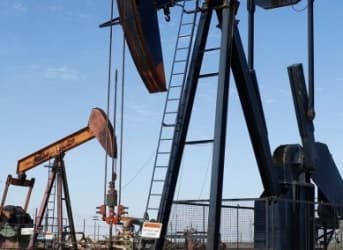Hydraulic fracturing, or fracking, has come full circle in Denton, Texas after a controversial ban on the practice entered into effect on Tuesday. Denton is one of several cities located on top of the massive Barnett shale formation, regarded as the birthplace of modern fracking. The ban, while incomplete, gives strength to what is a growing anti-fracking movement in the United States.
The Barnett shale covers an area of more than 5,000 square miles with depths between 5,000 and 8,000 feet. With more than 40 trillion cubic feet (Tcf) of technically recoverable gas, the Barnett holds approximately 12% of the nation’s proved reserves. Over the past decade, activity on the shale skyrocketed and over 15,000 wells have been drilled to date. For the state, the benefits are clear – in 2011 alone, Barnett production added nearly $13.7 billion to the Texas economy. However, production peaked in 2012 at 2 Tcf and will plummet by more than half toward 2030 – recent ban notwithstanding.

Source: EIA
Despite the success, fracking is not a victimless pursuit and its spread has been met with an unequal, but growing amount of public criticism; local bans and national moratoriums prove not everyone is on board. Earlier this year, Exxon CEO Rex Tillerson became party to a suit, which sought to remove fracking-related infrastructure from his Dallas suburb.
Related: Shale Permits Fall As Low Oil Prices Start To Bite
When carried out properly fracking is no more impactful than conventional drilling. However, when done incorrectly – and this is a source of contention – its costs outweigh the benefits. In short, the practice itself is not so much the worry, but instead its lightning-quick spread across the United States and into increasingly populated areas. Of primary concern are very real issues surrounding land use, water contamination, emissions, and seismic activity.
Science is moving behind the boom, but some startling trends are already apparent. Oklahoma, home to the 27.5 Tcf Woodford shale, has seen its seismic activity – virtually non-existent in the modern era – go through the roof since 2008. The increase is associated with wastewater, which is often pumped back into the Earth after a frack is complete. Between 2006 and 2012, Oklahoma re-injected more than one billion barrels of wastewater annually. And it’s not just Oklahoma – earthquake incidence is up in fracking territory across the central and eastern United States according to the United States Geological Survey (USGS).

Source: USGS
Related: The Oil Glut And An Inevtiable Oil Price Rebound
As science lags, so does regulation and an incomplete regulatory framework muddles the science. Missing information and under reporting create data holes that delay our understanding of an ever more widespread process. Enter civilian groups like Frack Free Denton, who aim to slow growth and take a more precautionary approach through science and technology.
Denton’s ban prohibits drilling within the city limits – about 270 wells – and joins other local referendums passed in California, Colorado, Ohio, and New York. The Texas Oil and Gas Association and the state’s General Land Office both filed lawsuits against the ban, but the city is prepared to defend its position.
ADVERTISEMENT
The lasting effect of such local referendums is yet to be seen, but they come at a difficult time for an oil and gas industry trying to find its way amid low prices – oil is down 40 percent since June. New well permits issued in November fell nearly 40 percent from the previous month which indicates a slowdown in shale plays across the US. Still, the Energy Information Administration believes the clamor from the fracking boom can sustain a few more naysayers.
By Colin Chilcoat of Oilprice.com
More Top Reads From Oilprice.com:
- Frac-Sands Poised For Huge Growth Despite Low Oil Prices
- Something Doesn’t Add Up In Bakken Production Figures
- Follow The Sand To The Real Fracking Boom


















